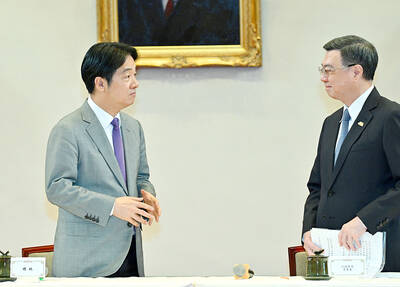The chayote melon does not feature in Taiwanese cuisine very much but it is ubiquitous primarily as the base from which chayote vines are grown. It is a member of the gourd family Cucurbitaceae, which includes cucumbers, as well as a wide range of other melons and squashes. It goes by many names, sometimes referred to rather unappealingly as the vegetable pear.
Originating in Latin America, chayote has spread across the world, acquiring a diverse variety of names such as chu-chu in Brazil, su-su in Vietnam and choko in Australia. It is a relatively late arrival in Taiwan, with cultivation in China dating back only to the 1920s, which may explain its relatively slim culinary profile despite its robustness as a crop and versatility in the kitchen.
Locally, it is most widely known as the Buddha hand melon (佛手瓜), possibly due to the cleft down the middle of the fruit, which can give it the appearance of two hands brought together in prayer. Others with less poetic imaginations have likened the appearance of the vegetable to aging buttocks, a description with just as much poetic validity if less marketing appeal.

Photo: Ian Bartholomew
Chayote is sometimes used in the popular Filipino dish tinola (or tinolang manok, a rich soup usually made with chicken) and can also be found in a wide variety of Latin American and Caribbean preparations. It is noted for being extremely bland — which has put many people off — but in fact this blandness is part of its special magic, as the flavor of a good tinola will attest.
At its simplest, the chayote melon can be eaten raw, just like a pear. It is not particularly appealing eaten this way, but thrown into a salad, it is a splendid replacement for apple. Served in raw slices with a Waldorf salad or any variation the apple-and-walnut theme, it can be preferable to apple, providing plenty of crush without the unwelcome (to me at least) sweetness that apples inject into the dish.
Chayote melon can be prepared in almost every way imaginable from steaming to frying, but it shows its star quality particularly in soups. It is rich in mucins, which thicken clear soups giving them a little extra body. These mucins are also particularly good for the health, adding to an impressive list of benefits that eating chayote can bring you. Chayote contains multiple nutrients and has anti-inflammatory properties that can aid in the treatment of high-blood pressure, kidney stones and indigestion. It is low in calories with plenty of dietary fiber as well, and is therefore a good choice for anyone working to control their weight.

Photo: Ian Bartholomew
Stir-frying the melon is a popular choice, and this can make a quick and tasty dish just by the addition of some pork and perhaps a splash of good stock. Given its blandness, the chayote reflects and often intensifies the flavor of the ingredients around it, which makes it a good accompaniment with blander meats such as boiled chicken or lean pork, highlighting, or even enhancing their subtle taste. Its crunchiness make it perfect served shredded or thinly sliced with a sesame oil dressing.
Chayote keeps well, and can be used with or without the skin. Personally, I favor peeling it, as the skin can be a little thick and fibrous. The mucins in the chayote make the peeled fruit slimy and while this, unlike plants such as mountain yam, will not cause skin irritation, it can feel unpleasant and gloves should be worn by the fastidious.
Sweet potato and chayote stew
with chicken
Recipe
(Serves 4)
This simple recipe is inspired by the Filipino dish tinolang manok and hits many of the same spots as this traditional winter soup. The body of the soup is given a luscious texture and sweetness by the mucins in the chayote, and the addition of sweet potato adds another dimension to the simple yet multilayered taste. It is perfect for cold wet days, and with its mild flavor, soft textures and rich nutritional content, it is just what the doctor ordered during any kind of convalescence, or simply for curling up with a good book and a blanket.
Ingredients
Half a chicken, chopped
2 small chayote melons
3 small sweet potatoes
500ml chicken stock (preferably homemade)
2 cloves garlic, minced
1 small onion, roughly chopped
A handful of shimeji mushrooms
A handful of fennel fronds, to garnish
2 tbsp olive oil
Salt and pepper to season
Directions
1. Peel and chop the chayote melon and remove any seeds in the center. Cut into bite-sized chunks. Peel the sweet potato and cut into similar-sized pieces.
2. Heat a pot over low heat and add olive. Add the onions and saute until they begin to turn translucent.
3. Add garlic and fry for another minute or so. Season with salt and pepper.
4. Add the chayote melon and saute for a couple of minutes, than add the stock and chicken. Bring to a boil then allow to simmer for 20 minutes.
5. Add the shimeji mushrooms. Adjust seasoning. Simmer for another 10 minutes.
6. Garnish with fennel fronds and serve warm.
Ian Bartholomew runs Ian’s Table, a small guesthouse in Hualien. He has lived in Taiwan for many years writing about the food scene and has decided that until you look at farming, you know nothing about the food you eat. He can be contacted at Hualien202@gmail.com.

Under pressure, President William Lai (賴清德) has enacted his first cabinet reshuffle. Whether it will be enough to staunch the bleeding remains to be seen. Cabinet members in the Executive Yuan almost always end up as sacrificial lambs, especially those appointed early in a president’s term. When presidents are under pressure, the cabinet is reshuffled. This is not unique to any party or president; this is the custom. This is the case in many democracies, especially parliamentary ones. In Taiwan, constitutionally the president presides over the heads of the five branches of government, each of which is confusingly translated as “president”

Sept. 1 to Sept. 7 In 1899, Kozaburo Hirai became the first documented Japanese to wed a Taiwanese under colonial rule. The soldier was partly motivated by the government’s policy of assimilating the Taiwanese population through intermarriage. While his friends and family disapproved and even mocked him, the marriage endured. By 1930, when his story appeared in Tales of Virtuous Deeds in Taiwan, Hirai had settled in his wife’s rural Changhua hometown, farming the land and integrating into local society. Similarly, Aiko Fujii, who married into the prominent Wufeng Lin Family (霧峰林家) in 1927, quickly learned Hoklo (commonly known as Taiwanese) and

The Venice Film Festival kicked off with the world premiere of Paolo Sorrentino’s La Grazia Wednesday night on the Lido. The opening ceremony of the festival also saw Francis Ford Coppola presenting filmmaker Werner Herzog with a lifetime achievement prize. The 82nd edition of the glamorous international film festival is playing host to many Hollywood stars, including George Clooney, Julia Roberts and Dwayne Johnson, and famed auteurs, from Guillermo del Toro to Kathryn Bigelow, who all have films debuting over the next 10 days. The conflict in Gaza has also already been an everpresent topic both outside the festival’s walls, where

The low voter turnout for the referendum on Aug. 23 shows that many Taiwanese are apathetic about nuclear energy, but there are long-term energy stakes involved that the public needs to grasp Taiwan faces an energy trilemma: soaring AI-driven demand, pressure to cut carbon and reliance on fragile fuel imports. But the nuclear referendum on Aug. 23 showed how little this registered with voters, many of whom neither see the long game nor grasp the stakes. Volunteer referendum worker Vivian Chen (陳薇安) put it bluntly: “I’ve seen many people asking what they’re voting for when they arrive to vote. They cast their vote without even doing any research.” Imagine Taiwanese voters invited to a poker table. The bet looked simple — yes or no — yet most never showed. More than two-thirds of those